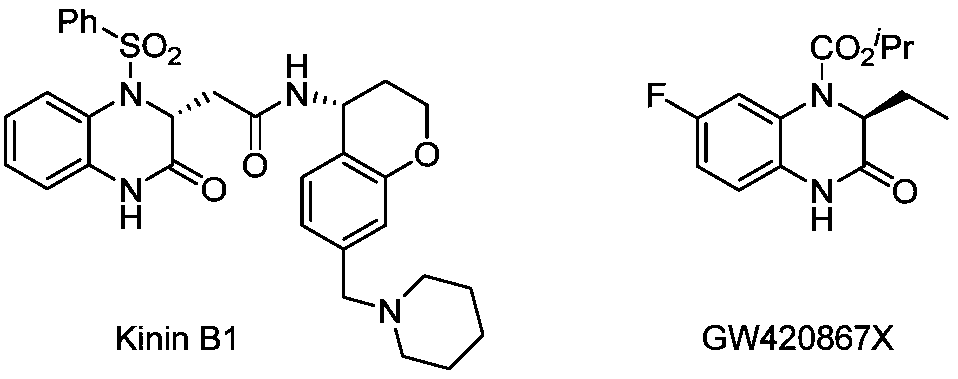Method for synthesizing chiral 3-trifluoromethyl-3, 4-dihydroquinoxalinone by palladium-catalyzed asymmetric hydrogenation
A technology for trifluoromethylquinoxalinone and dihydroquinoxalinone is applied in the field of asymmetric hydrogenation synthesis to achieve the effects of high reactivity and enantioselectivity, convenient separation, simple and practical reaction operation
- Summary
- Abstract
- Description
- Claims
- Application Information
AI Technical Summary
Problems solved by technology
Method used
Image
Examples
Embodiment 1-8
[0033] Optimization of conditions
[0034] Put palladium trifluoroacetate (0.0025 mmol, 0.85 mg) and chiral ligand (0.003 mmol) into the reaction flask, add 1 ml of acetone after nitrogen replacement, and stir at room temperature for 1 hour. Then it was concentrated in vacuo, and 3 ml of organic solvent was added under nitrogen, and the solution was transferred to a reaction kettle pre-placed with substrate 1a (27 mg, 0.125 mmol), fed with hydrogen gas at 600 psi, and reacted at 60°C for 48 hours. Release hydrogen slowly, remove solvent and obtain pure product by direct column chromatography separation, change the kind of organic solvent and chiral bisphosphine ligand in the reaction, the temperature of reaction, concrete structure such as table (table 1), reaction formula and coordination The body structure is as follows:
[0035]
[0036] The enantiomeric excess of the product was determined by chiral liquid chromatography, see Table 1.
[0037] Table 1. Asymmetric hydr...
Embodiment 9-23
[0041] Synthesis of Chiral Trifluoromethyldihydroquinoxalinones by Palladium-Catalyzed Asymmetric Hydrogenation 2
[0042] Palladium trifluoroacetate (1.7 mg, 0.0050 mmol) and (R)-SegPhos (3.4 mg, 0.0055 mmol) were put into the reaction flask, 1 ml of acetone was added after nitrogen replacement, and stirred at room temperature for 1 hour. Then concentrate in vacuo, add 3 milliliters of hexafluoroisopropanol under nitrogen, transfer this solution to a reaction kettle with substrate (0.25 mmol) in advance, feed hydrogen to 600 psi, react at room temperature for 48 hours, and slowly release hydrogen , to change the type of reaction substrate, as shown in Table 2. After removing solvent, direct column chromatography separates and obtains pure product, and reaction formula is as follows:
[0043]
[0044] Table 2. Substrate expansion for asymmetric hydrogenation of trifluoromethylquinoxalinones
[0045]
[0046] The corresponding products obtained in Examples 9-23 are resp...
PUM
 Login to View More
Login to View More Abstract
Description
Claims
Application Information
 Login to View More
Login to View More - R&D
- Intellectual Property
- Life Sciences
- Materials
- Tech Scout
- Unparalleled Data Quality
- Higher Quality Content
- 60% Fewer Hallucinations
Browse by: Latest US Patents, China's latest patents, Technical Efficacy Thesaurus, Application Domain, Technology Topic, Popular Technical Reports.
© 2025 PatSnap. All rights reserved.Legal|Privacy policy|Modern Slavery Act Transparency Statement|Sitemap|About US| Contact US: help@patsnap.com



